The Bulldog (also referred to as the “English Bulldog” or “British Bulldog”) is a medium-sized dog, often recognized by its muscular, heavy build and it’s wrinkled face and “smooshed” nose. According to the American Kennel Club, the bulldog is the 5th most popular breed of dog in the US.
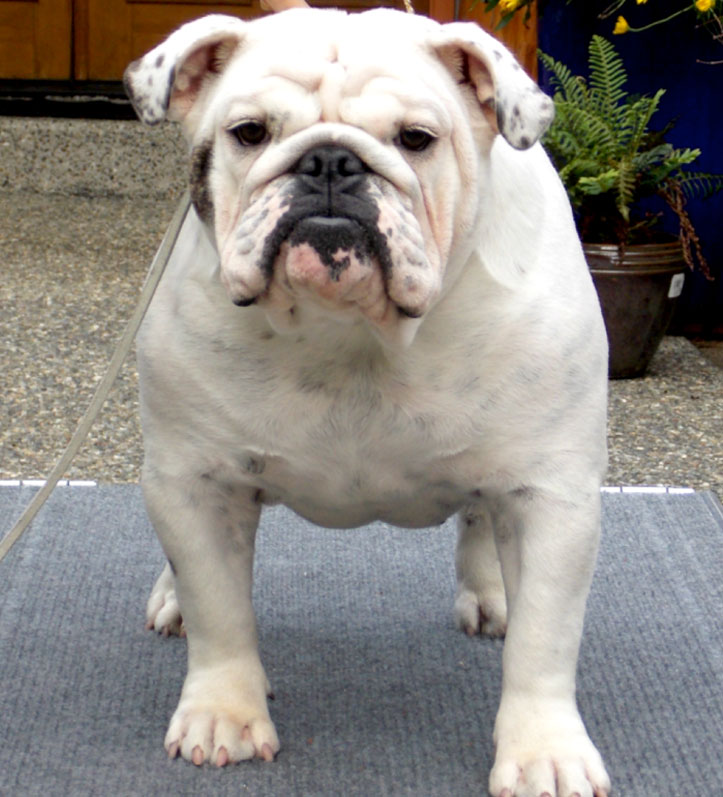
Bulldog Size
The average size of a mature male bulldog is approximately 50 pounds. For a mature female bulldog, the average size is approximately 40 pounds. Show dogs, however, tend to be heavier—by approximately 10 pounds. A bulldogs standing height is measured from their feet to the top of their shoulder blade, which averages about 12 to 15 inches.
Bulldog Appearance
The bulldog breed can be identified by the following characteristics:
- Wide head and shoulders
- Wrinkles (I.e, thick folds of skin) on the bulldog’s forehead
- Round, wide-set eyes
- Short muzzle with a fold of skin above the nose. This is called a “knot”.
- Loose, hanging skin under the neck
- Droopy lips
- Pointed teeth
- Short hair and a coat that’s flat and sleek.
- Bulldogs are colored white, red, fawn, brindle and piebald.
Bulldog Temperament
The American Kennel Club (AKC), has determined that a bulldog’s temperament should be:
“…equable and kind, resolute, and courageous (not vicious or aggressive), and demeanor should be pacific and dignified.”
Bulldog breeders aim to breed bulldogs to have a patient, friendly disposition. Bulldogs develop close attachments with children, which make them great family dogs. They also get along well with other pets.
Personality
Every bulldog is different, but in general, the bulldog breed is known for being friendly and sweet. The following adjectives can been used to describe the bulldog’s temperament:
- Dignified
- Easygoing
- Social
- Kind
- Stubborn
Here is a video of Wildflower the Bulldog and her puppy friend. Notice Wildflower’s calm and mellow demeanor.
What factors affect a bulldog’s personality?
Variations in personality are determined by a number of factors including genetics, training and how well the dog has been socialized.
When you’re deciding which bulldog puppy to take home as a pet, look for a puppy that is curious, playful and outgoing rather than a puppy that is timid. Also, pay close attention to any pups that seem to be bullying their siblings, as this could mean they’ll grow up to become aggressive. Be sure to meet the puppy’s parents if you can. If your puppy’s mother has a nice temperament then chances are your puppy will, too.
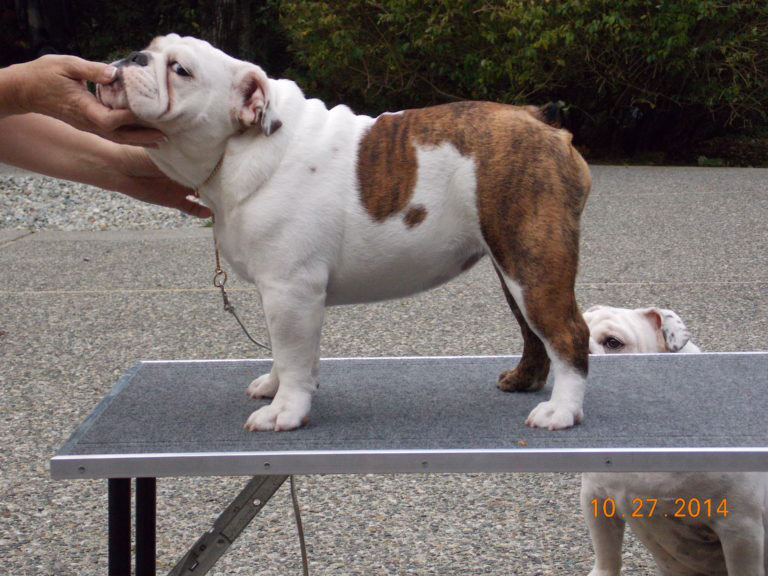
Early socialization helps
If you’ve recently brought home a bulldog puppy, it’s important to expose him or her to a variety of sights, sounds and people. You can do this regularly inviting friends over to the house, signing up your bulldog for a puppy training class and taking him or her to the dog park. This will help your bulldog become socialized and emotionally stable.
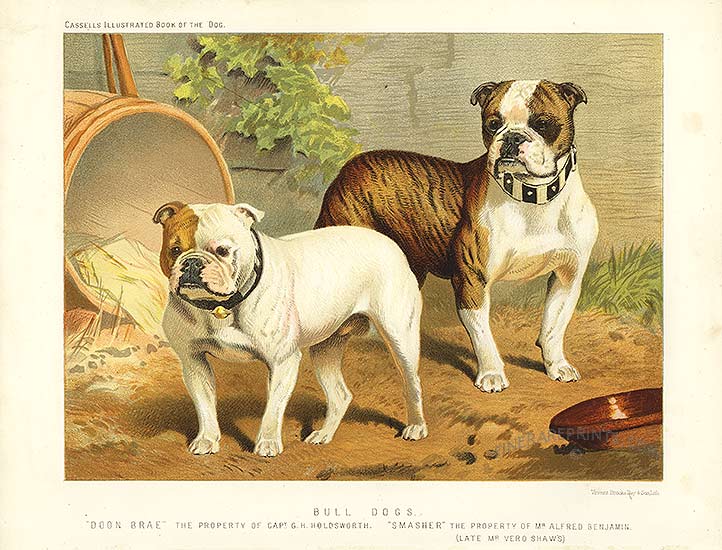
History of the Bulldog
It is thought that bulldogs originated in England, though the exact date is unknown. Like pitbulls, bulldogs were bred to coral livestock and later, for sport, in something known as “bull baiting”. How the sport worked was this: Bulldogs were put in a bull ring where they were expected to try to bite a bull by the nose nose and pull him to the ground. If the bulldog was able to do so, he’d be named a champion, spectators would place bets on which bulldog they thought would be victorious. Many bulldogs were maimed or killed during bull baiting events, which was what eventually led to the sport being outlawed in England by the Cruelty to Animals Act 1835. Thank goodness for that!
After bull baiting was banned, bulldogs were no longer considered a “sporting breed” in England and people’s interest in the breed waned to the point where they faced extinction. In the mid-1700s in the US, however, bulldogs became a popular work dog for New York immigrants who needed help rounding up the state’s population of wild bulls. Once again, the bulldogs were used to grab bulls by the nose, but this time it was in order to give the bulldog’s owner enough time to throw a rope around the bull’s neck and herd it away.
Today, the bulldog has become a popular companion animal. While back in its bullbaiting days, the bulldog was bred for aggression, in the centuries since then, bulldogs have been bred to be gentle and kind.
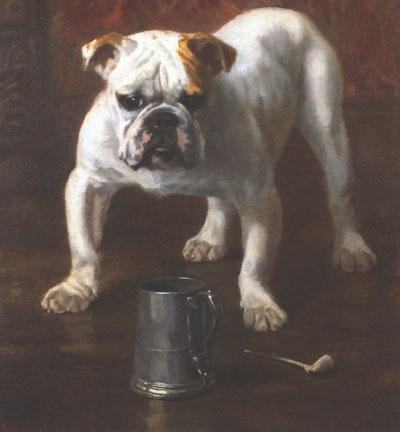
Portrait of a Bulldog by Frances C. Fairman. Painted in 1892
Bulldog Safety
No dog breed is alike and while the bulldog is a low-key and relatively low maintenance breed, there are some safety concerns that every owner should keep in mind:
Bulldogs need regular exercise
Bulldogs can be stubborn and lazy, which can sometimes mean they won’t want to go for a walk. But it’s important they receive an adequate amount of exercise in order to keep them fit and healthy. If a bulldog doesn’t get enough exercise, he or she can become weak and overweight.
Conversely, it’s also unhealthy for bulldogs to be over-exercised, because too much exercise can lead to joint problems.
Watch out for the heat and humidity
Bulldogs overheating can happen quicker than many people think. Bulldogs are sensitive to the heat and humidity because of their short lungs. It’s important to keep a close watch over your bulldog when he’s playing outside during the summer in order to ensure he doesn’t succumb to heat stroke.
Monitor their food intake
Bulldogs love to eat! They are prone to overeat, so it’s important you manage their meal portions. Because bulldogs aren’t as active as other breeds, they tend to gain weight easily, which is why it’s critical they aren’t allowed to eat more than the recommended amount.
0 – 3 months—Feed four times per day
3 – 6 months—Feed three times per day
6 to 12 months—Feed twice per day
12 months and older—Feed once to twice per day
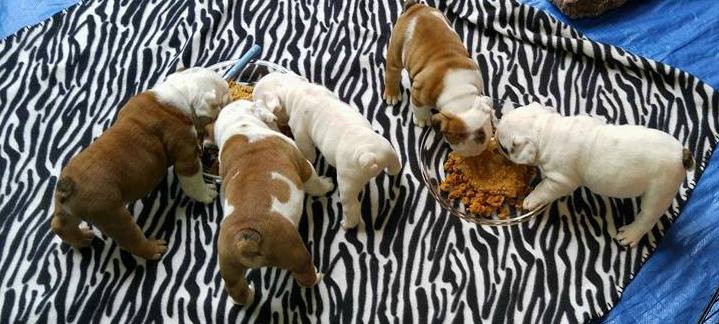
Bulldog Health
All purebred dogs are prone to health problems, and bulldogs are no exception. While not every bulldog will develop a disease or chronic health condition, it is important to know which ailments bulldogs are at risk of developing so that preventative measures can be taken.
One of the best ways to minimize health problems is by choosing a reputable bulldog breeder.
Read 9 Important Questions to Ask Your Bulldog Breeder for more details.
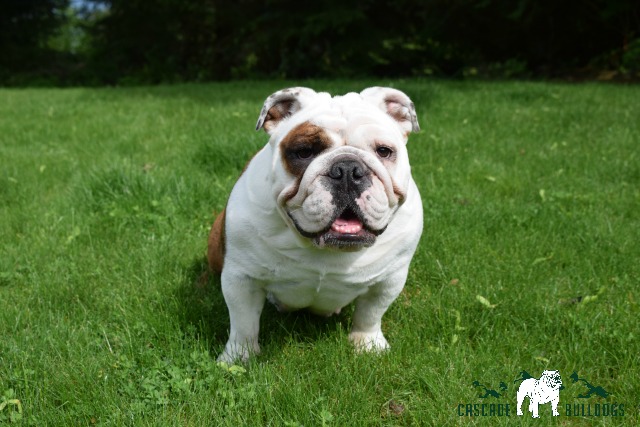
health of your bulldog
Wildflower the Bulldog, looking happy and healthy in the sunshine
Below are several common bulldog health problems:
Cherry Eye :
When a gland in the corner of a bulldog’s eye becomes swollen, it can bulge out of the eye, resembling a “cherry”. If this happens, take the bulldog to the vet, as it may need to be removed.
Dry Eye :
Dry eye is caused when bulldogs aren’t able to produce enough tears or eye moisture. This can be painful, but it can be healed with a prescription medication. Call the vet if your bulldog’s eye(s) takes on a blue haze or appears dry.
Brachycephalic Syndrome :
Brachycephalic means “short-headed”. Brachycephalic Syndrome is a term used to describe a disorder that commonly occurs with dog and cat breeds who have narrow nostrils and elongated soft palates. The breeds most commonly affected include the bulldog, French bulldog, pug, Boston terrier and Pekingese. Because dogs with Brachycephalic Syndrome have undersized or flattened breathing passages, they can have difficulty breathing. While snorting and labored breathing during exercise is normal for the bulldog and other breeds with this disorder, if their condition is particularly severe, they may need oxygen therapy or surgery.
Hip Dysplasia :
Because bulldogs have shallow hip joints, they can sometimes develop hip dysplasia, which is when the thigh bone doesn’t fit properly into the hip joint. This usually doesn’t cause any problems unless the bulldog becomes overweight or is overexercised as a puppy and young adult. If your bulldog seems to have trouble walking, standing up or climbing stairs, take him to the vet and get some x-rays. Medication or surgery may be required.
Entropion :
If a bulldog’s eyelashes revert inwards, they can irritate the eyes by rubbing against them. This condition is called Entropion and may require surgery.
Head Shakes :
If your bulldog is stressed or has low blood sugar, he might start shaking his head (either side to side or up and down). Although your bulldog will be conscious while it’s happening, the shaking will appear involuntary. Give your dog honey or something sweet to raise his blood sugar, but if this doesn’t work, take him to the vet.
Demodectic Mange or “Demodicosis” :
When a bulldog puppy is born, she inherits a demodex mite from her mom. The mite cannot be transferred to other dogs or to humans and can only be given from mother bulldog to baby. It lives in the hair follicles, unseen;but most of the time it isn’t harmful. If your Bulldog’s immune system is weakened, however, she can develop demodedic mange (i.e, bald spots and patches of red, raw-looking skin). In the localized version of demodedic mange, the rash-like symptoms will be limited to the head, neck and legs and will eventually clear up on its own. In the generalized version, the red patches may cover the entire body. If this is the case, check with your vet before breeding a dog who has generalized mange, because it might be inheritable.
Tail Skin Infections :
If your bulldog has an inverted tail or screw tail, he might be particularly prone to developing a skin infection underneath the skin folds on his tail. To prevent this, be sure to clean under the folds on a regular basis.
